Back at home, pick apart the seams (there is a kind of trick to it, so if you snip the right spot it will unzip, bam!). Find the cast off spot (usually nearest the neck) and pick that apart, then unravel. I still strongly recommend that you check out more expansive tutorials, but here are some tips that may help. Edited to add note: this makes quite a mess of snipped threads, binding edges and broken strands. Be prepared to vacuum/sweep! Just for this blog entry, I went to a thrift store and picked up a couple of sweaters to rip apart "on camera." The one that had the best potential was this green turtlneck, a 100% cotton J Crew men's LT. (See part one for info. on how I pick out sweaters.) This sweater had HUGE seams, which made it perfect for show & tell.
Just for this blog entry, I went to a thrift store and picked up a couple of sweaters to rip apart "on camera." The one that had the best potential was this green turtlneck, a 100% cotton J Crew men's LT. (See part one for info. on how I pick out sweaters.) This sweater had HUGE seams, which made it perfect for show & tell.
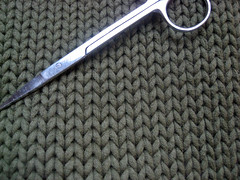 Tools
ToolsYou need: your sweater and a pair of small, sharp scissors. As you unravel the yarn, you can simply manually roll it into a ball, or you can use a tool: a swift, yarn/ball winder or a niddy noddy. You can make a niddy noddy by hammering 2 nails on a plank, a set distance apart. I think the nails on my "poor man's niddy noddy" were either 36 or 52 inches apart. (Helpful if you want to know approximately how many yards are in your skein.) I only have partial pics of mine in action, like this one or Charlie trying to "help."
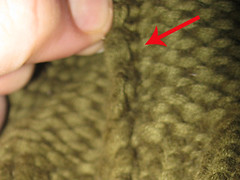 Carefully snip the seam threads. If you can find the right spot in a seam, you can snip one thread, then much of the seam (if not all) will just zip! right out.
Carefully snip the seam threads. If you can find the right spot in a seam, you can snip one thread, then much of the seam (if not all) will just zip! right out.On either side of the seam you'll find a row of stitches. Sometimes they're in a slightly different thread type or color, which is very helpful, but don't count on it. One side looks like a row of Vs and one looks like a row of vertical dashes. The first arrow is pointing to the "dashes."
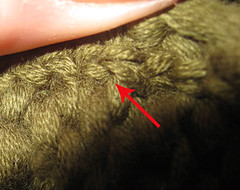 The second arrow is pointing to a less than ideal image of the row of Vs.
The second arrow is pointing to a less than ideal image of the row of Vs.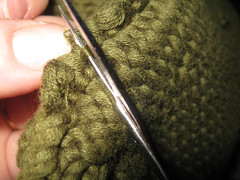 Align the sweater with an end of a seam nearest you, so the dashes are on the right and cut as close to the end as you can. (Sometimes cuffs are sewn slightly differently.) Snip the thread in one or two places, as shown.
Align the sweater with an end of a seam nearest you, so the dashes are on the right and cut as close to the end as you can. (Sometimes cuffs are sewn slightly differently.) Snip the thread in one or two places, as shown. 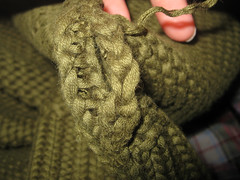 Tug the seam apart a little. Pull on the string to the right and it should just unzip. If it doesn't, try picking out a couple more stitches. If that doesn't work, the seam may have been sewn in a non-standard way.
Tug the seam apart a little. Pull on the string to the right and it should just unzip. If it doesn't, try picking out a couple more stitches. If that doesn't work, the seam may have been sewn in a non-standard way.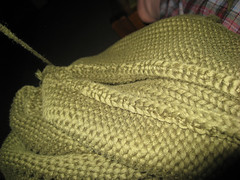 I'm sure it makes me a total geek when I admit that this gives me a bit of a high: finding a cooperative seam, making one or two snips, and then pulling one string to have the whole thing come apart. There are always the ends to work out, but this method speeds things up a bit.
I'm sure it makes me a total geek when I admit that this gives me a bit of a high: finding a cooperative seam, making one or two snips, and then pulling one string to have the whole thing come apart. There are always the ends to work out, but this method speeds things up a bit.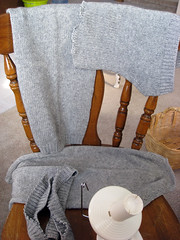 Continue snipping and zipping until you've disassembled the sweater. (Obviously a different sweater!)
Continue snipping and zipping until you've disassembled the sweater. (Obviously a different sweater!)Next, find the cast-off edge (should always be the top, since garments are traditionally knit bottom up). You may need to pick apart the first row -- factory-made garments are often bound off with thread. Then start unraveling.
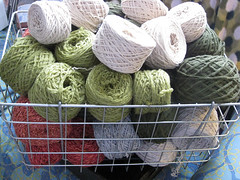 Most of the sweaters I buy for unraveling are hand-wash only, so I don't bother with that until after it's unraveled. If the yarn isn't stinky, I just ball it up and work from there. If I need to know the yardage (I hope to buy a yarn meter soon) or wash it, I wind it into loops (you can use a swift, a niddy noddy, or a plank with a nail in either end), and tie it off in 2-3 places. In loop form, the yarn can be soaked for awhile, then hung up to dry. This also removes the kinks. Once it's dry, I twist it into skeins and store it until I need to use it. At that time, I wind it back into balls.
Most of the sweaters I buy for unraveling are hand-wash only, so I don't bother with that until after it's unraveled. If the yarn isn't stinky, I just ball it up and work from there. If I need to know the yardage (I hope to buy a yarn meter soon) or wash it, I wind it into loops (you can use a swift, a niddy noddy, or a plank with a nail in either end), and tie it off in 2-3 places. In loop form, the yarn can be soaked for awhile, then hung up to dry. This also removes the kinks. Once it's dry, I twist it into skeins and store it until I need to use it. At that time, I wind it back into balls.This picture shows most of the balls (a couple are missing) from less than $20 worth of thrift store sweaters.

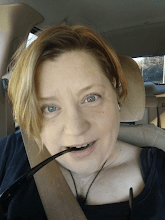
No comments:
Post a Comment